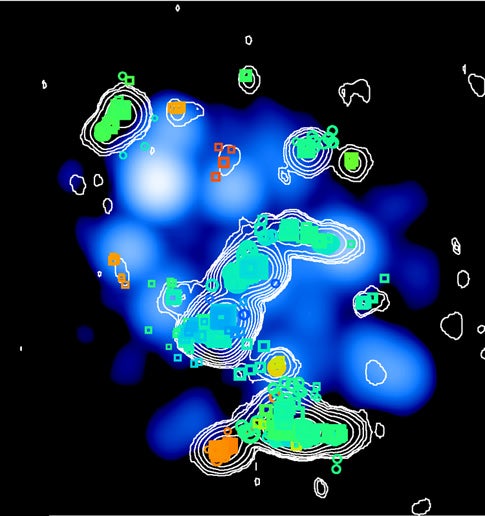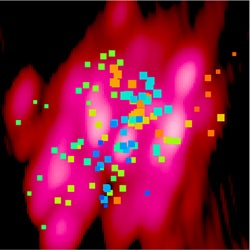Steamy clouds have been observed bubbling away from four massive stars known as red supergiants. A team from Jodrell Bank Observatory, using the MERLIN array and European and Global VLBI Networks, found that the stars are actually steaming as they enter their final death throes, driving out thick clouds of water vapor immersed in more tenuous gas.
Dr. Anita Richards, who will present today at the Royal Astronomical Society’s National Astronomy Meeting in Preston, U.K. said, “Red supergiants lose more than half their mass before ending their lives as supernovae. Our observations show that this doesn’t happen smoothly, like an onion shedding layers. We see water vapor clouds, which are over-dense and over-magnetized, are rapidly accelerating away from the star. They are embedded in a cooler, more diffuse gas producing distinctive emission from hydroxyl, a break-down product of water.”
The group studied ‘maser’ emissions from the gas clouds surrounding the star: molecules in the gas amplify and emit beams of microwave radiation in much the same way as a laser produces very narrow, bright beams of light. Water emits at 1.3 cm wavelength, under hot, dense conditions (around 1000 kelvins). Hydroxyl emission at 18 cm can only occur from cooler, less dense gas, and it was very unexpected to detect it as close to two of the stars as the water masers. The only explanation seems to be that the water masers come from clumps where the gas density is, which is typically 50 times higher than the rest of the wind from the star. Supporting evidence comes from measurements of the magnetic field strength associated with the hydroxyl masers, which is much weaker than that of the adjacent water masers, as is expected if the hydroxyl environment is more diffuse.
In the study, the maser emissions from the water vapor appeared to show that the clouds had a lifetime of only a few decades, although clouds were observed at distances that would have taken about a century to reach. The puzzle was solved by comparing the MERLIN results with long-term observations from the Puschino Radio Telescope in Russia, which revealed individual clouds winking off and back on again due to the fickle nature of maser excitation, or beaming. Richards said, “These observations are intriguing because, from the size of the masing shell, we estimate that the water vapor clouds take about 100 years to bubble away into interstellar space, but we can only actually ‘see’ any particular cloud for a few years.”











